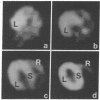Abstract
The muscarinic receptor was studied in vivo in the human heart by a noninvasive method, positron emission tomography (PET). The study showed that the binding sites of 11C-labeled methiodide quinuclidinyl benzilate [( 11C]-MQNB), a muscarinic antagonist, were mainly distributed in the ventricular septum (98 pmol/cm3 of heart) and in the left ventricular wall (89 pmol/cm3), while the atria were not visualized. A few minutes after a bolus intravenous injection, the concentration of [11C]MQNB in blood fell to a negligible level (less than 100th of the concentration measured in the ventricular septum). When injected at high specific radioactivity, the concentration of [11C]MQNB in the septum rapidly increased and then remained constant with time. This result was explained by rebinding of the ligand to receptors. It was the major difference observed between the kinetics of binding of [11C]MQNB to receptor sites after intravenous injection in vivo and that of [3H]MQNB to heart homogenates in vitro. The MQNB concentrations in the ventricular septum of different individuals were found to be highest when the heart rate at the time of injection was slow. This result suggests that the antagonist binding site is related to a low-affinity conformational state of the receptor under predominant vagal stimulation. Thus, positron emission tomography might be the ideal method to study the physiologically active form of the muscarinic acetylcholine receptor in man.
Full text
PDF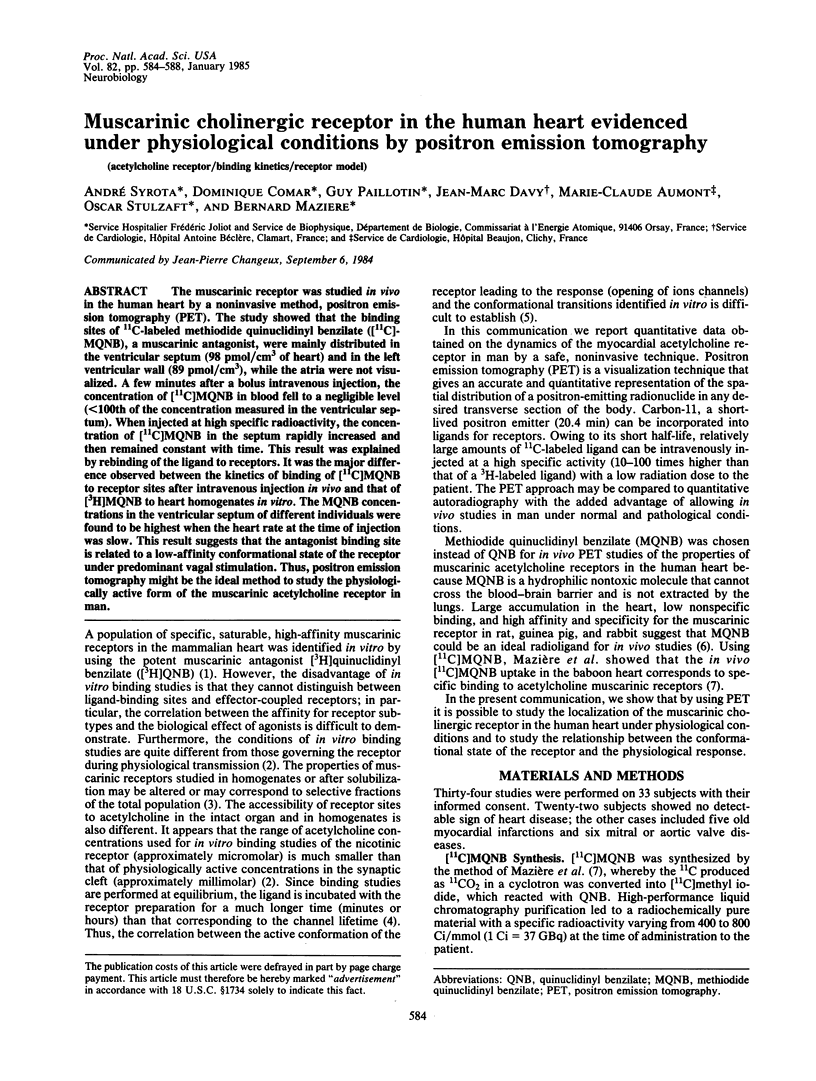
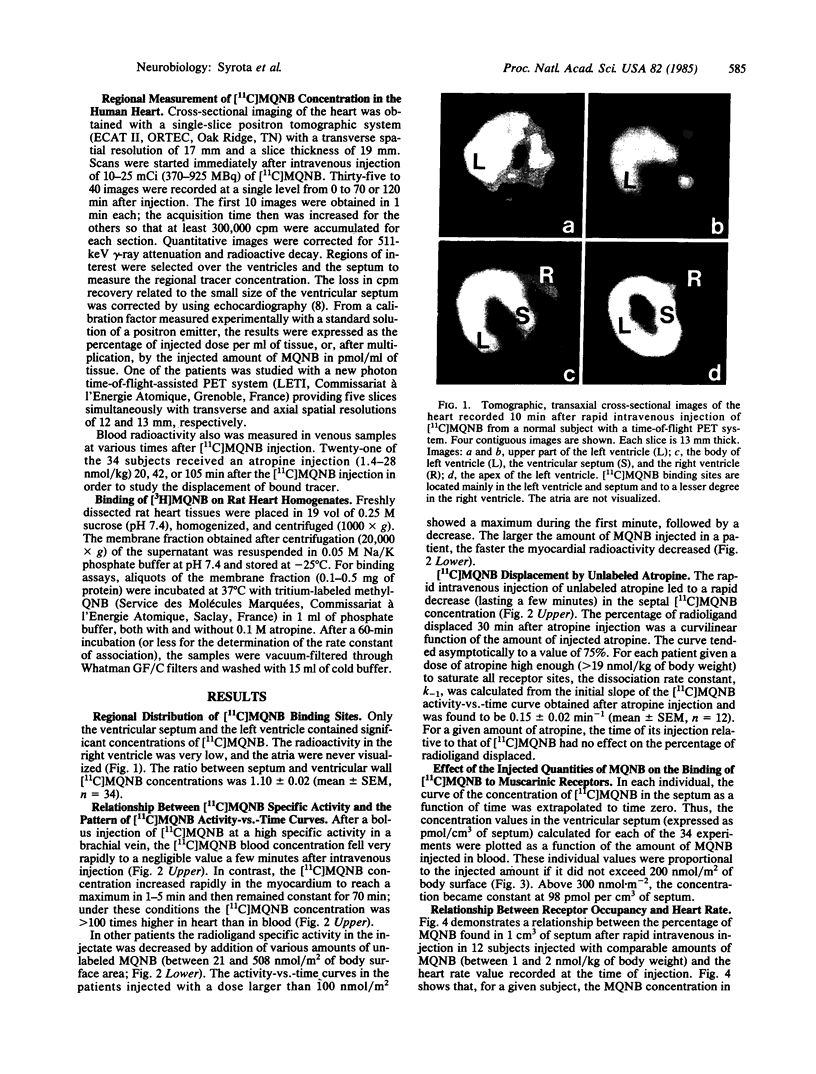
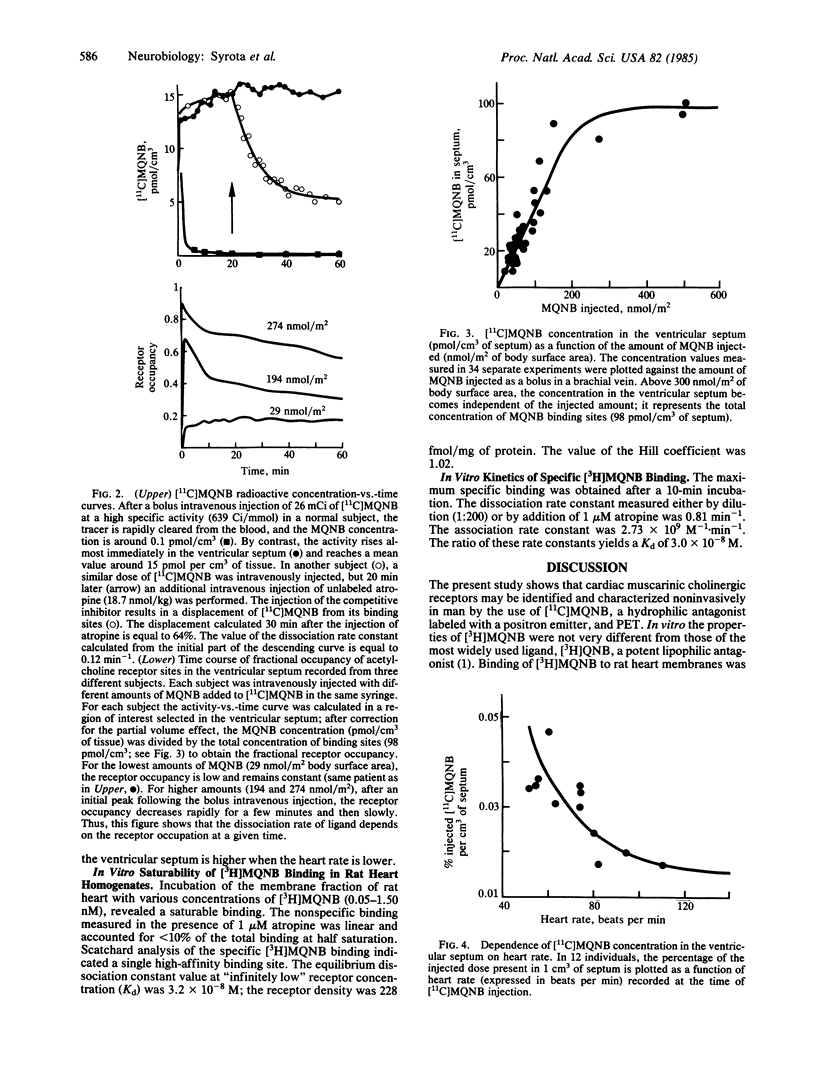
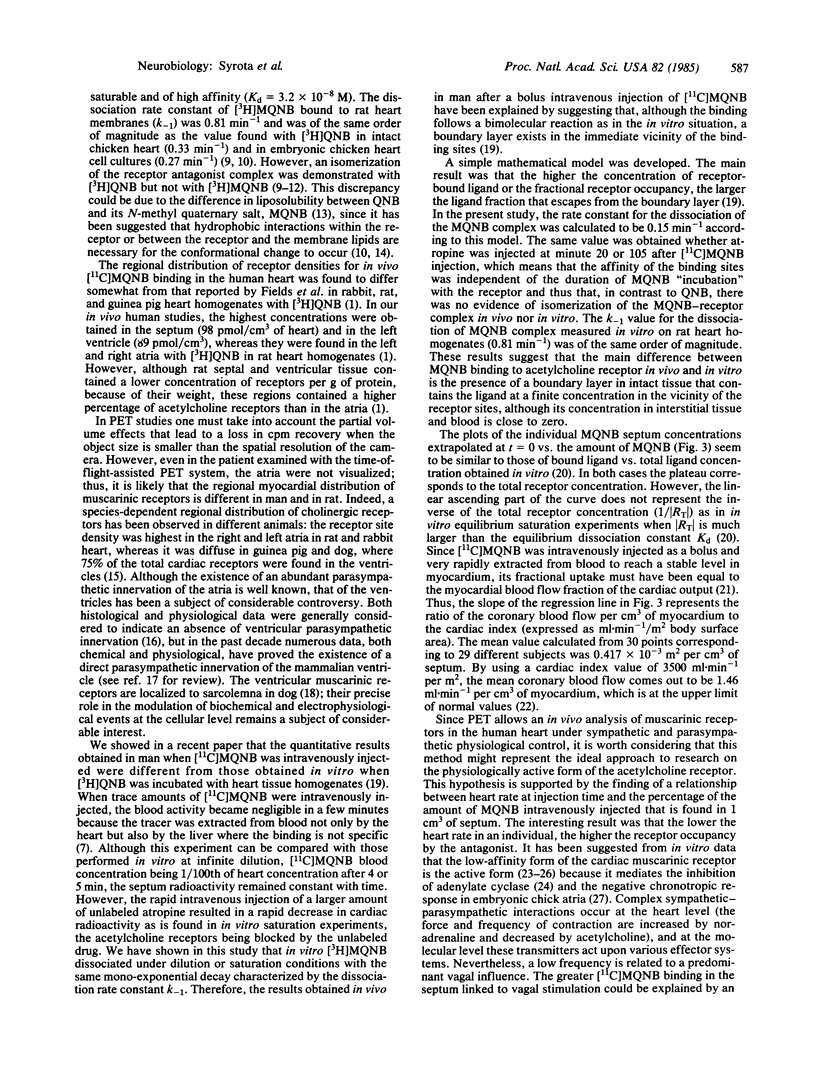
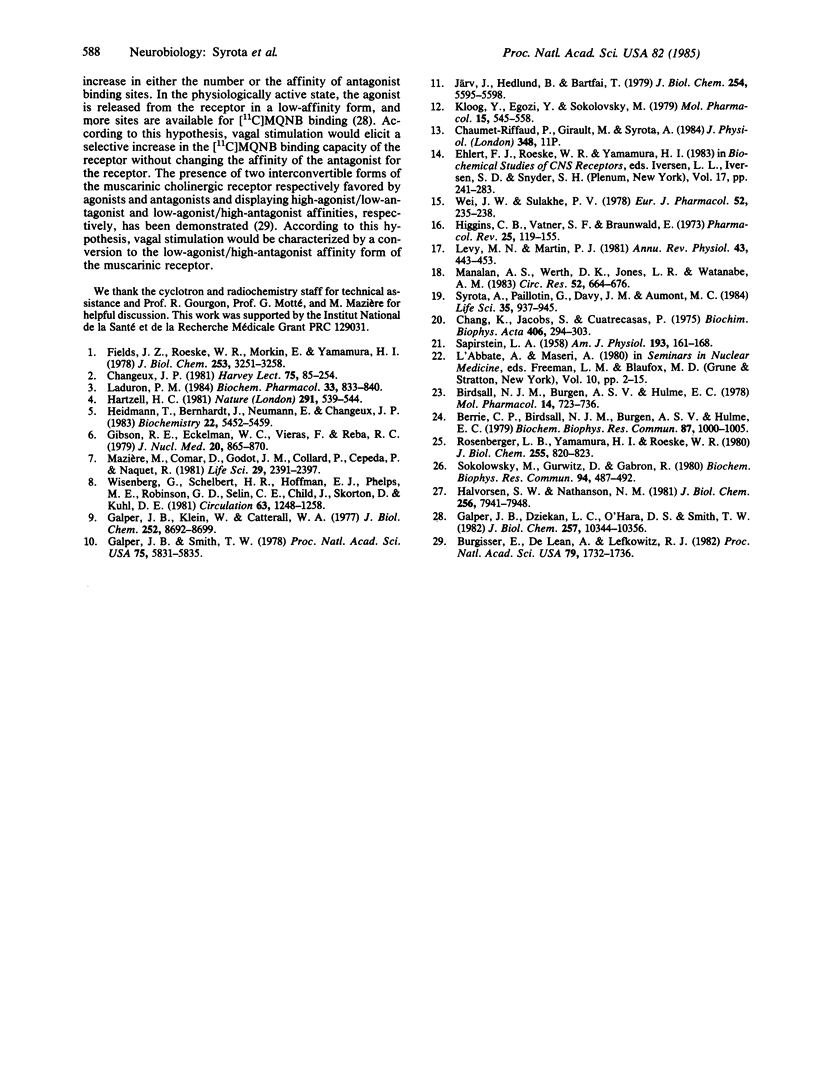
Images in this article
Selected References
These references are in PubMed. This may not be the complete list of references from this article.
- Berrie C. P., Birdsall N. J., Burgen A. S., Hulme E. C. Guanine nucleotides modulate muscarinic receptor binding in the heart. Biochem Biophys Res Commun. 1979 Apr 27;87(4):1000–1005. doi: 10.1016/s0006-291x(79)80006-6. [DOI] [PubMed] [Google Scholar]
- Birdsall N. J., Burgen A. S., Hulme E. C. The binding of agonists to brain muscarinic receptors. Mol Pharmacol. 1978 Sep;14(5):723–736. [PubMed] [Google Scholar]
- Burgisser E., De Lean A., Lefkowitz R. J. Reciprocal modulation of agonist and antagonist binding to muscarinic cholinergic receptor by guanine nucleotide. Proc Natl Acad Sci U S A. 1982 Mar;79(6):1732–1736. doi: 10.1073/pnas.79.6.1732. [DOI] [PMC free article] [PubMed] [Google Scholar]
- Chang K. J., Jacobs S., Cuatrecasas P. Quantitative aspects of hormone-receptor interactions of high affinity. Effect of receptor concentration and measurement of dissociation constants of labeled and unlabeled hormones. Biochim Biophys Acta. 1975 Oct 6;406(2):294–303. doi: 10.1016/0005-2736(75)90011-5. [DOI] [PubMed] [Google Scholar]
- Changeux J. P. The acetylcholine receptor: an "allosteric" membrane protein. Harvey Lect. 1979 1980;75:85–254. [PubMed] [Google Scholar]
- Fields J. Z., Roeske W. R., Morkin E., Yamamura H. I. Cardiac muscarinic cholinergic receptors. Biochemical identification and characterization. J Biol Chem. 1978 May 10;253(9):3251–3258. [PubMed] [Google Scholar]
- Galper J. B., Dziekan L. C., O'Hara D. S., Smith T. W. The biphasic response of muscarinic cholinergic receptors in cultured heart cells to agonists. Effects on receptor number and affinity in intact cells and homogenates. J Biol Chem. 1982 Sep 10;257(17):10344–10356. [PubMed] [Google Scholar]
- Galper J. B., Klein W., Catterall W. A. Muscarinic acetylcholine receptors in developing chick heart. J Biol Chem. 1977 Dec 10;252(23):8692–8699. [PubMed] [Google Scholar]
- Galper J. B., Smith T. W. Properties of muscarinic acetylcholine receptors in heart cell cultures. Proc Natl Acad Sci U S A. 1978 Dec;75(12):5831–5835. doi: 10.1073/pnas.75.12.5831. [DOI] [PMC free article] [PubMed] [Google Scholar]
- Gibson R. E., Eckelman W. C., Vieras F., Reba R. C. The distribution of the muscarinic acetylcholine receptor antagonists, quinuclidinyl benzilate and quinuclidinyl benzilate methiodide (both tritiated), in rat, guinea pig, and rabbit. J Nucl Med. 1979 Aug;20(8):865–870. [PubMed] [Google Scholar]
- Halvorsen S. W., Nathanson N. M. In vivo regulation of muscarinic acetylcholine receptor number and function in embryonic chick heart. J Biol Chem. 1981 Aug 10;256(15):7941–7948. [PubMed] [Google Scholar]
- Hartzell H. C. Mechanisms of slow postsynaptic potentials. Nature. 1981 Jun 18;291(5816):539–544. doi: 10.1038/291539a0. [DOI] [PubMed] [Google Scholar]
- Heidmann T., Bernhardt J., Neumann E., Changeux J. P. Rapid kinetics of agonist binding and permeability response analyzed in parallel on acetylcholine receptor rich membranes from Torpedo marmorata. Biochemistry. 1983 Nov 8;22(23):5452–5459. doi: 10.1021/bi00292a029. [DOI] [PubMed] [Google Scholar]
- Higgins C. B., Vatner S. F., Braunwald E. Parasympathetic control of the heart. Pharmacol Rev. 1973 Mar;25(1):119–155. [PubMed] [Google Scholar]
- Järv J., Hedlund B., Bartfai T. Isomerization of the muscarinic receptor . antagonist complex. J Biol Chem. 1979 Jul 10;254(13):5595–5598. [PubMed] [Google Scholar]
- Kloog Y., Egozi Y., Sokolovsky M. Characterization of muscarinic acetylcholine receptors from mouse brain: evidence for regional heterogeneity and isomerization. Mol Pharmacol. 1979 May;15(3):545–558. [PubMed] [Google Scholar]
- Laduron P. M. Criteria for receptor sites in binding studies. Biochem Pharmacol. 1984 Mar 15;33(6):833–839. doi: 10.1016/0006-2952(84)90436-2. [DOI] [PubMed] [Google Scholar]
- Levy M. N., Martin P. J., Stuesse S. L. Neural regulation of the heart beat. Annu Rev Physiol. 1981;43:443–453. doi: 10.1146/annurev.ph.43.030181.002303. [DOI] [PubMed] [Google Scholar]
- Manalan A. S., Werth D. K., Jones L. R., Watanabe A. M. Enrichment, solubilization, and partial characterization of digitonin-solubilized muscarinic receptors derived from canine ventricular myocardium. Circ Res. 1983 Jun;52(6):664–676. doi: 10.1161/01.res.52.6.664. [DOI] [PubMed] [Google Scholar]
- Mazière M., Comar D., Godot J. M., Collard P., Cepeda C., Naquet R. In vivo characterization of myocardium muscarinic receptors by positron emission tomography. Life Sci. 1981 Dec 7;29(23):2391–2397. doi: 10.1016/0024-3205(81)90475-6. [DOI] [PubMed] [Google Scholar]
- Rosenberger L. B., Yamamura H. I., Roeske W. R. Cardiac muscarinic cholinergic receptor binding is regulated by Na+ and guanyl nucleotides. J Biol Chem. 1980 Feb 10;255(3):820–823. [PubMed] [Google Scholar]
- SAPIRSTEIN L. A. Regional blood flow by fractional distribution of indicators. Am J Physiol. 1958 Apr;193(1):161–168. doi: 10.1152/ajplegacy.1958.193.1.161. [DOI] [PubMed] [Google Scholar]
- Sokolovsky M., Gurwitz D., Galron R. Muscarinic receptor binding in mouse brain: regulation by guanine nucleotides. Biochem Biophys Res Commun. 1980 May 30;94(2):487–492. doi: 10.1016/0006-291x(80)91257-7. [DOI] [PubMed] [Google Scholar]
- Syrota A., Paillotin G., Davy J. M., Aumont M. C. Kinetics of in vivo binding of antagonist to muscarinic cholinergic receptor in the human heart studied by positron emission tomography. Life Sci. 1984 Aug 27;35(9):937–945. doi: 10.1016/0024-3205(84)90659-3. [DOI] [PubMed] [Google Scholar]
- Wei J. W., Sulakhe P. V. Regional and subcellular distribution of myocardial muscarinic cholinergic receptors. Eur J Pharmacol. 1978 Nov 15;52(2):235–238. doi: 10.1016/0014-2999(78)90212-1. [DOI] [PubMed] [Google Scholar]
- Wisenberg G., Schelbert H. R., Hoffman E. J., Phelps M. E., Robinson G. D., Jr, Selin C. E., Child J., Skorton D., Kuhl D. E. In vivo quantitation of regional myocardial blood flow by positron-emission computed tomography. Circulation. 1981 Jun;63(6):1248–1258. doi: 10.1161/01.cir.63.6.1248. [DOI] [PubMed] [Google Scholar]



